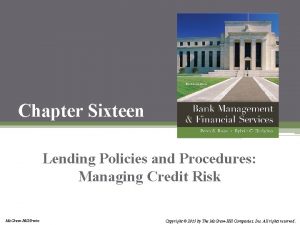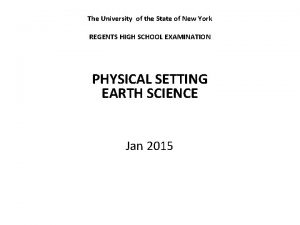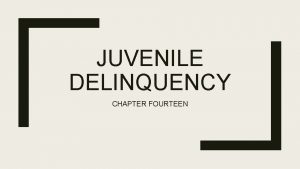Chapter Fourteen Other Lending Institutions Savings Institutions Credit
























- Slides: 24

Chapter Fourteen Other Lending Institutions: Savings Institutions, Credit Unions, and Finance Companies Mc. Graw-Hill/Irwin 8 -1 © 2009, The Mc. Graw-Hill Companies, All Rights Reserved

Savings Institutions (SIs) • Historically referred to as Savings and Loans (S&Ls) • Savings banks (SBs) appeared in the 1980 s • Specialize in long-term residential mortgages, which are usually financed with short-term deposits of small savers • Faced a huge crisis during the 1982 -1992 period that saw over half of all SIs fail Mc. Graw-Hill/Irwin 14 -2 © 2009, The Mc. Graw-Hill Companies, All Rights Reserved

The S&L Crisis of 1982 -1992 • Some 4, 000 SIs existed at the end of the 1970 s • By 2007, only 1, 257 SIs exist • The Federal Reserve radically changed its monetary policy during October 1979 to October 1982 – – targeted reserves rather than interest rates led to sudden surge in interest rates many SIs faced negative spreads SIs lost depositors because of Regulation Q Mc. Graw-Hill/Irwin 14 -3 © 2009, The Mc. Graw-Hill Companies, All Rights Reserved

The S&L Crisis of 1982 -1992 • Depository Institutions Deregulations and Monetary Control Act (DIDMCA) of 1980 and Garn-St. Germain Depository Institutions Act (GSGDIA) of 1982 addressed the crisis – allowed interest-bearing transaction accounts – allowed SIs to offer floating- or adjustable-rate mortgages – allowed expansion into real estate development and commercial lending – some SIs chose to invest in the junk bond market and suffered large losses when the junk bond market collapsed in the mid 1980 s Mc. Graw-Hill/Irwin 14 -4 © 2009, The Mc. Graw-Hill Companies, All Rights Reserved

The S&L Crisis of 1982 -1992 • Real estate and land prices collapsed in many areas of the U. S. in the mid-1980 s – many mortgages defaulted as a result • The Federal Savings and Loan Insurance Corporation (FSLIC) had a policy of regulatory forbearance – i. e. , its policy was to not close economically insolvent FIs, allowing them to continue to operate • 1, 248 SIs failed in the 1982 to 1992 period – the FSLIC became massively insolvent as a result Mc. Graw-Hill/Irwin 14 -5 © 2009, The Mc. Graw-Hill Companies, All Rights Reserved

The S&L Crisis of 1982 -1992 • The Financial Institutions Reform, Recovery, and Enforcement Act (FIRREA) of 1989 – abolished the FSLIC – created a new Savings Association Insurance Fund (SAIF) that was put under the management of the Federal Deposit Insurance Corporation (FDIC) – replaced the Federal Home Loan Bank Board with the Office of Thrift Supervision (OTS) – created the Resolution Trust Corporation (RTC) to close and liquidate insolvent SIs – the Qualified Thrift Lender Test (QTL) sets a floor on the mortgage-related assets that thrifts must hold (currently at 65%) – introduced Prompt Corrective Action (PCA), which mandates that regulators must close problem banks and thrifts faster Mc. Graw-Hill/Irwin 14 -6 © 2009, The Mc. Graw-Hill Companies, All Rights Reserved

SI Balance Sheets (2007) • Mortgages and mortgage backed securities (MBSs) represent 73. 2% of total assets – compares to 33. 7% for commercial banks • Commercial loans represent 3. 9% of total assets – compares to 11. 7% for commercial banks • Consumer loans represent 5. 0% of total assets – compares to 8. 4% for commercial banks • Cash and investment securities represent 10. 1% of total assets – compares to 32. 3% for commercial banks Mc. Graw-Hill/Irwin 14 -7 © 2009, The Mc. Graw-Hill Companies, All Rights Reserved

SI Balance Sheets (2007) • Transaction accounts and small time deposits are the predominant source of funds for SIs – total deposits account for 65. 9% of total liabilities and net worth • The second most important source of funds is borrowings from the 12 Federal Home Loan Banks (FHLBs) • Net worth is the book value of the equity holders’ capital contribution – 11. 9% compares to 10. 1% for commercial banks – most SIs were historically mutual organizations – many have switched to stock charters in order to more easily attract capital investment Mc. Graw-Hill/Irwin 14 -8 © 2009, The Mc. Graw-Hill Companies, All Rights Reserved

Regulation of SIs • The primary regulator of nationally chartered SIs is the Office of Thrift Supervision (OTS) – established in 1989 under the FIRREA • State agencies regulate state chartered SIs • The FDIC oversees the deposit insurance fund of SIs – the Savings Association Insurance Fund (SAIF) from 1989 to 2007 – the Deposit Insurance Fund (DIF) since January 2007 Mc. Graw-Hill/Irwin 14 -9 © 2009, The Mc. Graw-Hill Companies, All Rights Reserved

Recent Trends for SIs • Experienced record profits in the mid- to late 1990 s as interest rates were low and the U. S. economy prospered • Like commercial banks, SIs experienced substantial consolidation in the 1990 • The downturn in the U. S. economy eroded SIs’ profitability in 2000 • The subprime mortgage crisis of the mid-2000 s has hit SIs quite hard Mc. Graw-Hill/Irwin 14 -10 © 2009, The Mc. Graw-Hill Companies, All Rights Reserved

Credit Unions (CUs) • Not-for-profit depository institutions mutually organized and owned by their members (depositors) • First established in the early 1900 s as self-help organizations – members deposit savings and the funds are lent to other members • CUs are prohibited from serving the general public—i. e. , members are required to have a common bond of occupation, association, etc. • Because CUs are not-for-profit, their earnings are not taxed – offer higher interest rates than commercial banks on deposits – charge lower interest rates than commercial banks on loans Mc. Graw-Hill/Irwin 14 -11 © 2009, The Mc. Graw-Hill Companies, All Rights Reserved

Credit Unions (CUs) • Most numerous of all depository institutions: 8, 329 CUs in 2007 • Less affected by the crisis of the 1980 s that hit SIs and CBs hard – traditionally, more than 40% of their assets are in small consumer loans – loans are funded with deposits – tend to hold large amounts of government securities as assets – hold small amounts of residential mortgages Mc. Graw-Hill/Irwin 14 -12 © 2009, The Mc. Graw-Hill Companies, All Rights Reserved

Credit Unions (CUs) • National credit union system consists of three tiers – U. S. Central Credit Union is the top tier • provides investment and liquidity services to Corporate CUs – 34 Corporate Credit Unions comprise the middle tier at the state or regional level • cooperatively owned by their member CUs • serve members by investing and lending excess funds that member CUs place with them • provide settlement services, securities safekeeping, etc. – individual credit unions make up the bottom tier Mc. Graw-Hill/Irwin 14 -13 © 2009, The Mc. Graw-Hill Companies, All Rights Reserved

Credit Unions (CUs) • Recently CUs have expanded their services to compete with CBs and SIs – many have converted to a common charter to expand their customer base – now offer mortgages, credit lines, and ATMs – some offer business and commercial loans to their employer groups • Banking industry challenged CU expansion in 1997 – Supreme Court sided with the banking industry – Congress quickly passed a bill that sided with CUs Mc. Graw-Hill/Irwin 14 -14 © 2009, The Mc. Graw-Hill Companies, All Rights Reserved

CU Balance Sheets (2007) • Total assets of all CUs is less than the total assets of the single largest commercial bank – total assets of all CUs is $748. 3 billion – total assets of Citigroup alone is $2, 358. 3 billion • Consumer loans represent 31. 8% of total assets – compares to 8. 4% at CBs and 5. 0% at SIs • Home mortgages represent 40. 2% of total assets – compares to 33. 7% at CBs and 73. 2% at SIs • Investment securities represent 18. 1% of total assets – compares to 27. 9% at CBs and 8. 0% at SIs – 54. 7% of the investment portfolio is in U. S. government or federal agency securities Mc. Graw-Hill/Irwin 14 -15 © 2009, The Mc. Graw-Hill Companies, All Rights Reserved

CU Balance Sheets (2007) • 86. 3% of total funding comes from member deposits – compares to 65. 9% for CBs and 61. 1% for SIs – share draft transaction accounts account for 36. 0% of all CU deposits – certificates of deposit (CDs) account for 22. 8% of all CU deposits – money market deposit accounts (MMDAs) account for 18. 4% of CU deposits – share accounts account for 13. 0% of CU deposits • CU equity is the accumulation of past earnings that is “owned” collectively by member depositors Mc. Graw-Hill/Irwin 14 -16 © 2009, The Mc. Graw-Hill Companies, All Rights Reserved

CU Regulators and Performance • 62. 1% of CUs are federally chartered – regulated by the National Credit Union Administration (NCUA) – deposit insurance is provided by the National Credit Union Share Insurance Fund (NCUSIF) • Remaining CUS are regulated at the state level • Assets grew by more than 10% annually from 1999 to 2007 • Membership increased from 63. 6 million to 90. 2 million from 1999 to 2007 • ROA decreased from 1999 to 2007, but not a huge concern as CUs are not-for-profit organizations Mc. Graw-Hill/Irwin 14 -17 © 2009, The Mc. Graw-Hill Companies, All Rights Reserved

Finance Companies (FCs) • There are three major types of finance companies (FCs) – sales finance institutions specialize in loans to customers of a particular retailer or manufacturer – personal credit institutions specialize in installment and other loans to consumer – business credit institutions specialize in business loans, especially through factoring • factoring is the process of purchasing accounts receivables from corporations, usually with no recourse to the seller should the receivables go bad Mc. Graw-Hill/Irwin 14 -18 © 2009, The Mc. Graw-Hill Companies, All Rights Reserved

Finance Companies (FCs) • Industry assets were $2, 159. 7 billion in 2007 • FC industry is highly concentrated – the 20 largest FCs account for more than 75% of industry assets – many of the largest FCs are captive subsidiaries (i. e. , wholly owned subsidiaries of parent corporations) – GMAC Commercial Mortgage Corp. , a FC subsidiary of General Motors Acceptance Corp. (GMAC), is the largest business unit of General Motors and is the largest commercial lender in the U. S. Mc. Graw-Hill/Irwin 14 -19 © 2009, The Mc. Graw-Hill Companies, All Rights Reserved

Balance Sheets of FCs (2007) • Business and consumer loans (called accounts receivables) represent 54. 0% of total assets • Consumer loans include motor vehicle loans and leases and other loans, which are often at higher interest rates than CBs because FCs lend to riskier customers – subprime lenders are FCs that lend to high risk customers – loan sharks are subprime lenders that charge unfairly exorbitant rates to desperate subprime borrowers – payday lenders provide short-term cash advances that are often due when borrowers receive their next paycheck Mc. Graw-Hill/Irwin 14 -20 © 2009, The Mc. Graw-Hill Companies, All Rights Reserved

Balance Sheets of FCs (2007) • FCs often have advantages over CBs with respect to business loans because FCs: – are not subject to regulations that restrict the type of products and services they can offer – do not accept deposits—accordingly, bank-type regulators do not monitor their behavior – often have substantial industry and product expertise – are more willing to accept risky customers – generally have lower overhead than CBs Mc. Graw-Hill/Irwin 14 -21 © 2009, The Mc. Graw-Hill Companies, All Rights Reserved

Balance Sheets of FCs (2007) • Real estate loans represent 26. 1% of total assets – second mortgages are in the form of home equity loans, i. e. , loans that let customers borrow on a line of credit secured with a second mortgage on their home – securitized mortgage assets are mortgages purchased and used as assets backing secondary market securities – mortgage servicing is a fee-related activity whereby the flow of mortgage repayments is collected and passed on to investors in whole mortgage loan packages or securitization vehicles Mc. Graw-Hill/Irwin 14 -22 © 2009, The Mc. Graw-Hill Companies, All Rights Reserved

FC Performance and Regulators • Problems arose in the FC industry in the mid-2000 s with the crash of the market for subprime mortgage loans – many FCs saw sharply lower equity values • FCs are subject to state imposed usury ceilings • Because FCs do not accept deposits, they are not subject to the extensive oversight that CBs, SIs, and CUs are • FCs signal their safety and soundness to investors with higher capital-to-assets ratios Mc. Graw-Hill/Irwin 14 -23 © 2009, The Mc. Graw-Hill Companies, All Rights Reserved

Global Issues • Unlike the U. S. , SIs in Europe traditionally catered to the commercial industry • The majority of SIs in Europe are mutually owned • SIs worldwide are quite small compared to CBs • Nonbank FI lending has increased in both Latin America and in Europe in the last decade • Postal SIs exist in about 30 countries throughout the world, mostly in Europe – operate virtually as full-service banks – many post offices have savings products linked to stock markets Mc. Graw-Hill/Irwin 14 -24 © 2009, The Mc. Graw-Hill Companies, All Rights Reserved
 Lending policies and procedures managing credit risk
Lending policies and procedures managing credit risk Contractual savings institutions
Contractual savings institutions Arizona state savings credit union
Arizona state savings credit union Iphil savings and credit cooperative
Iphil savings and credit cooperative This can be avoided by giving credit where credit is due.
This can be avoided by giving credit where credit is due. Chapter 5 savings accounts
Chapter 5 savings accounts Chapter 30 savings accounts
Chapter 30 savings accounts 14 line iambic pentameter poem
14 line iambic pentameter poem A fourteen-line lyric poem
A fourteen-line lyric poem Eleven twelve thirteen fourteen fifteen
Eleven twelve thirteen fourteen fifteen Wilsons fourteen points and the treaty of versailles
Wilsons fourteen points and the treaty of versailles Isi wilson's fourteen points
Isi wilson's fourteen points Octave in sonnet
Octave in sonnet The diagram below represents the placoderm fish
The diagram below represents the placoderm fish A fourteen line poem with prescribed rhyme of scheme
A fourteen line poem with prescribed rhyme of scheme Siya ang may akda ng fourteen points
Siya ang may akda ng fourteen points Fourteen line lyric poem
Fourteen line lyric poem A 14 line lyric poem
A 14 line lyric poem Siya ang may akda ng fourteen points
Siya ang may akda ng fourteen points A fourteen line lyric poem
A fourteen line lyric poem Arkitaypal teorya ng pampanitikan
Arkitaypal teorya ng pampanitikan Fourteen one act play summary
Fourteen one act play summary Plank gang
Plank gang Fourteen points and treaty of versailles similarities
Fourteen points and treaty of versailles similarities Quality is free: the art of making quality certain
Quality is free: the art of making quality certain















































